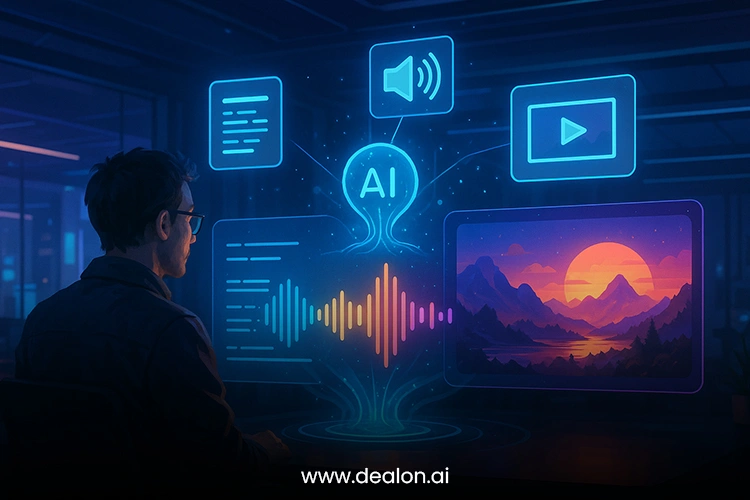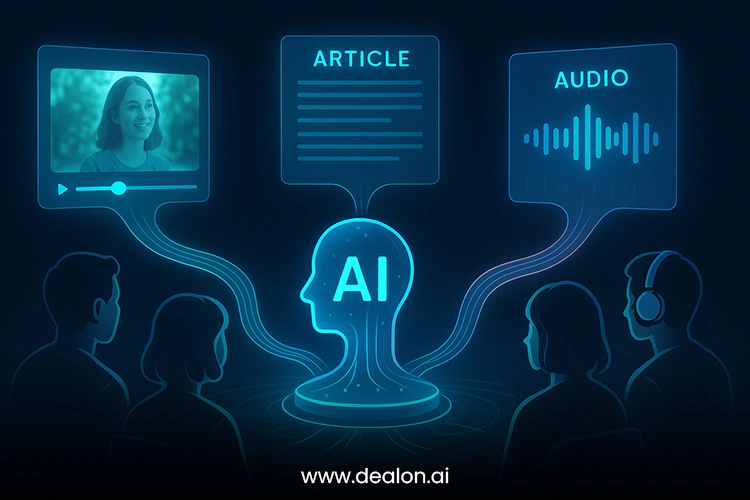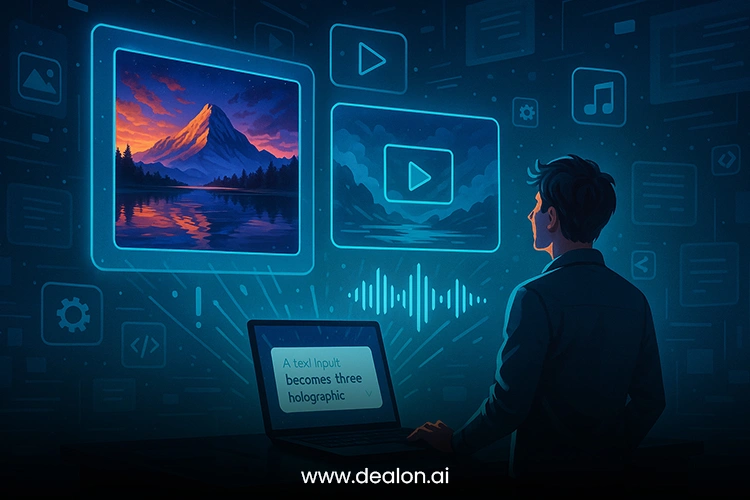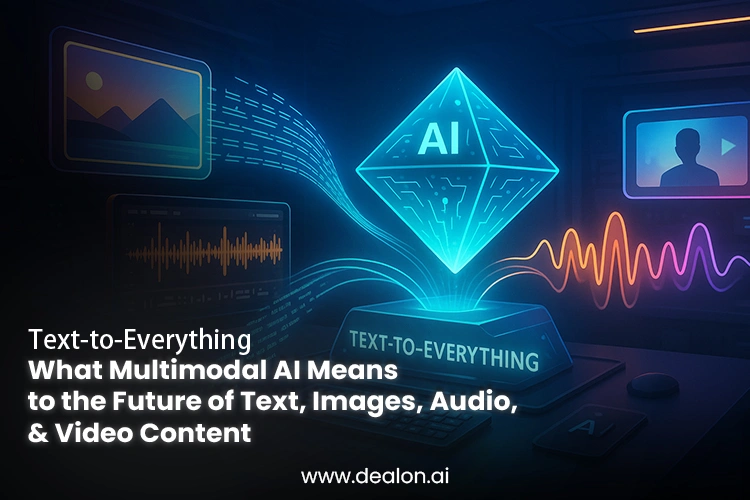The content creation landscape is undergoing a paradigm shift like never before because of the emergence of multimodal AI. This innovative technology harmoniously incorporates text, images, audio, and video in one creative process. Previously, the content creators used to use different tools to create various types of media, i., written articles, pictures, videos, and audio. These silos are today being eradicated by text-to-everything models, allowing creators to create rich interactive work in many formats using the same input. This technological shift in artificial intelligence is transforming not just the pace but also the quality of content creation. It presents new possibilities not only to businesses and marketers, but also to personal creators.
Multimodal AI works through the processing and comprehension of different forms of media in parallel, and such capabilities enable it to generate dynamic content to suit the preferences of multiple audiences. As an example, a mere textual prompt may now be converted not only to a blog post but even to a marketing campaign with visuals, videos, and audio samples. This potential opens up to more interesting, immersive content that has a more profound impact on consumers. Instead of using human producers to assemble non-related content fragments manually, AI can create coherent and multi-sensory experiences through real-time creation.
The uses of this technology are enormous. It has brought businesses and marketers to a level of personalized and hyper-targeted content at scale, maximizing customer engagement across channels and platforms. Similarly, multimodal AI can be utilized by individual creators to generate content without having to use many resources or without technical expertise. The boundary between human creativity and machine-generated content will blur as AI keeps developing, and the age of interdependence of the former and the latter will emerge, which will become a necessity when it comes to designing compelling digital experiences. This post investigates multimodal AI and its implications on the future of content creation and the radical change it introduces to how we interact with digital media.
Also Read: How Agentic AI is Changing Customers’ Workflows Silently
The Multimodal AI Renaissance: Text, Audio, and Visuals.

Multimodal AI is changing the content creation landscape radically as it allows text, audio, images, and video to be smoothly blended in the same production process. This change is a departure from the conventional AI models that are usually biased in terms of accepting only a single form of media, e.g., text or images. The emergence of multimodal AI has allowed creators and businesses to now work with an AI system capable of managing multiple types of media at once, which opens the door to richer, more dynamic content experiences.
The real strength in multimodal AI is that it allows it to synthesize data across different channels and smoothly integrate it to produce content that speaks more to people. To illustrate, a multimodal AI-generated written article may include automatically customized images, infographics, and videos in accordance with the context of the text. This will avoid manual intervention, which used to take special tools and time-consuming work. Multimodal AI allows making content more interesting, interactive, and accessible, which is a vital characteristic in the process of attracting the attention of modern consumers who are becoming more inclined to consume information in different formats.
Practically, AI in multimodal form increases the possibilities of creativity. Being able to turn the text into video or audio without the use of any external software creates new opportunities in the content creation. The limitations of individual media are no longer the concern of the content creators. Instead, AI can give them the capability to create complex, cross-modal content, be it an explainer video, a social media post, or even a personalized audio guide, without needing to coordinate several tools.
It is not simply a revolution of efficiency; it is a revolution of producing content that will reach more people. Individuals read, listen, and hear, and some people listen to the content more than others. In the case of multimodal AI, creators can fulfill these higher expectations, providing content that appeals to a specific audience’s preferred form of consumption. The combination of various media types enables the brands to appeal to consumers in a more holistic and inclusive approach, providing different options for how to convey their message.
The Multimodal AI and the Improvement of the Quality of Content and Personalization

The capacity of multimodal AI to improve the quality of content through the combination of automation and the understanding of the context is one of its major strengths. The workflows of creation of traditional content are usually fragmented, i.e., text is written, images are sourced, videos are edited, and audio is mixed separately. This division may result in wastage and unpredictability in the finished product.
Multimodal AI overcomes this by considering the entire context of the content and generating full-fledged and integrated output representations of content in multiple forms. This combined strategy makes every piece of content contextually and aesthetically aligned, which makes them more effective and engaging to the target audience.
In addition, the degree of individualization that is done by multimodal AI is unparalleled. AI can customize content based on the interests of a particular person by using data like user activity, tastes, and previous engagement. As one instance, an AI system might generate a custom video experience in which the visual and textual content change depending on the viewer and their browsing history or demographic profile.
This would take a lot of human effort in the traditional content creation process, where customer data must be analyzed, different versions of content must be created, and each version must fit particular user traits. In multidimensional AI, however, this is automated, and hyper-selection can be created dynamically, generating content that is hyper-targeted and would be difficult or impossible to do manually.
Such ability is a business-changer, and marketers can now design content that connects directly to the individual. Beyond developing generic and general marketing content, brands can produce personalized videos, advertisements, product inspirations, and other content that match the interests of a particular customer and his or her preferences. The on-the-fly content adaptation of AI means that the message delivery will work not only to be relevant but also timely, which enhances the likelihood of engagement and conversion.
As an example, consider an AI-based product video, where the AI automatically creates the video to showcase the products that best fit the preferences of a given customer- filtered by their browsing history, location, or purchase history. This hyper-target marketing will be more inclined to create an interest. It will provoke a response since it will address the particular desires of the consumer in a more personalized shopping experience.
Besides this, multimodal AI has a significant impact on the scale of a brand in its marketing endeavors due to its rapid and efficient nature in producing personalized content. It now takes a fraction of the time that might have taken weeks or months to develop a series of personalized campaigns or customized product content, and the saved time allows valuable human resources to be allocated to more productive strategic efforts.
Moreover, with multimodal AI constantly learning and adapting, the content is going to be continuously improving as time goes on. With the increase in the amount of data collected, the AI will optimize its algorithms to create more accurate content, so that marketing activities become more efficient and more specific. Real-time optimization of content is critical in a digital environment where there is a quick change in users’ preferences and trends.
The purpose of Text-to-Image, Text-to-Video, and Text-to-Audio in Content Creation

Multimodal AI is providing a fresh opportunity to content makers as it allows the text to be converted to many forms, like images, videos, and audio, with ease. The transition of conventional content creation practices is radically cutting down the time it takes to produce, and creative tools are more readily available than ever. Text-to-everything features enable creators not only to make textual content but also to create multi-format content with a single prompt.
AI Text-to-Image generators such as DALL-E and MidJourney have transformed the process of visual content generation. Transforming plain text descriptions to contextually rich images, such tools do not require stock photographs or expensive custom design services. Text-to-image technology can be an effective remedy for creators who need fast and original visuals to use in blogs, social media posts, or marketing campaigns. Think about creating a custom cover image for a blog post or a set of personalized drawings for a marketing campaign–created based on short text descriptions. This saves time as well as adds a particular element of creativity that is hard to do manually, and this offers a degree of customization that is unparalleled.
Another game changer in the content creation world is the Text-to-Video. In the past, video production was a labor-intensive process, which demanded scripting, filming, and a lot of post-production editing. Multimodal AI, however, has simplified this process, and now creators can convert written content into captivating video content with limited human intervention.
With nothing more than text as input, AI is capable of generating the visuals, voiceovers, background music, and even the sounds. The feature is convenient when you need multiple explainer videos, tutorials, product demos, or promotion videos. This renders the process of creating video much simpler, as well as making high-quality video content accessible to a larger number of creators, irrespective of their technical skills and the resources they possess.
Text-to-Audio technologies are similarly making the creation of audio democratized. AI can create realistic audio based on written material, whether in the form of podcasts, audiobooks, or voiceovers, without the need for professional voice actors or costly sound recording and editing software and equipment. Text-to-audio applications may turn into audio of high quality with a natural and flowing sound when reading articles or scripts.
They can use these tools to develop customized audio content at a fraction of the time with customizable speech patterns, tones, and accents. It is advantageous to any person interested in diversifying their content regarding the ways they can transform blog posts into podcasts or voiceovers on social media videos. The power to generate audio content rapidly not only broadens the capacity of producers but is also part of the growing need for audio-first content in the present digital environment.
Combined, text-to-image, text-to-video, and text-to-audio AI features are changing the content creation and consumption process. These multimodal tools permit creators to interact with their viewers in a multi-faceted, immersive manner wherein multiple types of media are combined into a unified, cohesive experience. These tools enable the creators to be more creative and efficient because the technical and time constraints that are historically connected with content production are minimized, and the creators are free to explore and make more dynamic content that will appeal to their audience.
Content Implications and Marketer Implications
Multimodal AI is not only exclusive to big companies with large content creation departments- it also positively affects individual creators, small enterprises, and marketers who might need to create great content faster. These AI tools enable creators to redirect their efforts into other, more strategic areas of content creation, including their creative direction, messaging, and engagement with their audience by automating much of the content creation process. The latter comes in with exceptional value in the modern digital era of rapid changes, when the content must be regularly new, topical, and correspond to the audience’s preferences.
To marketers, multimodal AI gives them the capability to build a unified brand experience on the various platforms. Be it social media, email marketing, or web content, now the brands can be confident in maintaining a consistent message, tone, and style across text, image, video, and audio use. With just one text prompt, brands can create content that blends these formats flawlessly, making sure that their marketing content is cohesive and professional and flexible across platforms. This cross-channel consistency makes the brand more identifiable, hence more recognizable and relatable to the customers.
Also, AI is multimodal, which means that it opens the gateway to joint creativity. Although AI can create the bases of the content, users can further develop it, giving it their own personal touches, fine-tuning the message, and making it fit into their brand voice. This is a balance between automation and human input that creates efficient and very creative content. The AI-generated content can be used as a baseline in a collaborative environment to enable teams to adapt and start to build on ideas quickly. The result of this union between AI potential and human ingenuity is likely to change the process of content creation, making it more flexible and adjusting to market trends.
The Multimodal AI Future in Content Creation
In the future, multimodal AI will likely continue to evolve into an even more advanced and context-sensitive entity; it will include more real-time flexibility and interactivity. These systems are highly dynamic and will be customized to provide highly dynamic content experiences as they continue to evolve and learn the preferences of the users. Such functionality to modify content with user behavior and interaction will help creators of such content to create more personalized, targeted content that will touch individual audience members at a more personal level.
Furthermore, the future of multimodal AI is in its combination with the new technologies that include augmented reality (AR) and virtual reality (VR). Such a combination of AI and immersive technologies will erase the boundaries between online and offline experiences, offering new possibilities to creators to attract audiences in new ways. To give an example, with AI, it may be possible to create virtual spaces or interactive experiences using text, audio, and graphics in a completely immersive 3D space. With the improved technology, the content creation will become more interactive and experiential, and consumers may now utilize content in a manner that was never imagined before.
As AI-generated content continues to spread, creators and businesses will be required to find a way to integrate AI into their brand stories in an authentic manner. Although AI is unbelievably efficient and creatively powerful, brands must keep a sense of authenticity and human touch in their message. It will be an era of a sympathetic relationship between the automation of multimodal AI and human invention and creativity in the future of content creation. Finally, multimodal AI will be on the frontline of transforming the way content is created, read, and perceived, which offers an extensive creative potential.
Conclusion
Multimodal AI is turning the world of content creation upside down by flawlessly incorporating text, pictures, video, and audio into one interactive system. The technology will improve creativity, efficiency, and personalization, and enable creators and businesses to create rich, engaging content in different formats with little effort. Text-to-image and text-to-video, text-to-audio, and so on, AI helps creators to communicate with their audience in creative and varied ways. With the ever-evolving multimodal AI, the future of content creation, consumption, and experience will be redefined and present incomparable opportunities in personalization, collaboration, and creativity. Adoption of these AI-powered tools will determine the future of content creation.

